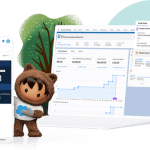India’s retail industry has evolved at an incredible pace—from paan shops peppered across the country, to local kiranas, to modern trade and e-commerce. COVID-19 has only accelerated the rate of change, as lockdowns and store closures prompt retailers and consumers to pivot to digital faster than anticipated.
Since then, consumer expectations and behaviours have shifted. Our State of the Connected Customer Report suggests that customers use about nine channels to browse inventory, seek advice,and make purchases.
Meanwhile, 80% of customers say that the experience a company provides is as important as its products or services. What’s more, 83% of customers expect flexible shipping and fulfilment options such as buy-online-pick-up-in-store.
According to McKinsey’s consumer pulse survey, 94% of Indian consumers have tried a new shopping behaviour since COVID-19, and most intend to continue with it. Some are exploring new digital shopping methods or different retailers/brands/websites, while others are experimenting with private labels/ store brands. These behavioural changes are impacting customer loyalty, making it imperative for retailers to rethink customer retention strategies.
As online shopping picks up steam, e-commerce segments in India are poised to grow faster in 2021, driven by:
- Online grocery, where the entry of Reliance and Tata will spur competition.
- E-pharmacy, owing to consolidation in the sector and tailwinds from COVID-19.
- Social commerce, with increased VC investments and focus from tech giants such as Facebook. While e-commerce and search-based shopping brought in the first wave of online shoppers, social commerce and discovery-based shopping are expected to drive the next wave.
- Direct to Consumer (D2C) models, with more brands investing in direct channels to own the consumer relationship.
- Super apps, which could transform the way consumers shop by consolidating payments, chatbots, personalised shopping lists, recommendations, and more on one app.
Big trends impacting retail in India
- Contactless engagements (mobile payments, no-contact deliveries, virtual tours, AR/VR-led consultations, and home visits).
- Growth in select sub-sectors driven by increased spend on essentials, nutrition, wellness, and hygiene (discretionary spending has been deprioritised).
- Digital as a platform not just for sales, but for inspiration, social affirmations, and brand building.
- Shift to D2C as brands understand the importance of staying close to the consumer amidst intense competition. The focus will be on building consumer awareness and feeding insights back into new product development and e-commerce strategies.
- Increased investments in home nesting as homes become the centre of all activities (work, leisure, study, and comfort).
- The rise of local and private labels, thanks to increasing consumer experimentation (e.g., lounge-wear), expectations, and choice, as well as the limited availability of specific products (e.g., a certain sanitizer brand or packaged staples).
- The importance of local kiranas in fulfilment and last mile delivery/servicing.
What does the Indian consumer really want?
Consumer expectations will continue to evolve, but optimism levels will be closely linked to how COVID-19 impacts lives and livelihoods. Having said that, vaccinations are picking up, and will likely accelerate consumer spending and shopping.
The last 10-15 months have offered retailers enough information and insights into what the Indian consumer really seeks:

Implications for retailers
Based on consumer expectations and industry trends, omni-channel will be the most obvious imperative for retailers. But here are a few other aspects and questions for your retail business to think through while planning digital investments and priorities:
Drive agility with data and analytics:

Technologies like AI/ ML can unlock insights from across front- and back-end systems to help you transform your business at scale, while also refining strategy.
Strengthen business relationships:

Like consumers, retail vendors and sales channel partners expect a seamless journey, from onboarding, to sales enablement and beyond. Find ways to empower them, and accelerate partnership growth by being nimble and ready for opportunities.
Build loyalty:

In our State of the Connected Customer report, 84% of customers said that being treated as a person, not a number is very important to winning their business. Enter persona-based targeting. This marketing strategy can help you reach new audiences, and engage shoppers more effectively. A 360-degree customer view can also help you personalise products, services, and offers better.
Meet shoppers where they are:

The path to purchasing is different for each shopper. As a retailer, you must provide a consistent and frictionless experience, no matter the channel or touchpoint.
Many retailers are also pushing shopping experiences to the edge on channels like social media and video streaming, so that shoppers are just one click away from that purchase.
Reimagine the role of the store and its employees: While digital shopping is here to stay, physical stores will continue to be important touchpoints. But they are likely to be reimagined as experience centres and micro-fulfilment sites.

Driven by safety concerns, more consumers are buying online and picking up in-store. New restrictions and regulations are also limiting in-store shopping. To adapt to these trends quickly, stores will need to have efficient and agile processes.
Retail focus areas in 2021 and beyond
Over the coming months, retailers will be challenged to keep up with changing customer needs, scale up digital investments, and re-envision stores for flexible and experiential shopping. In this new reality, technology-driven commerce can help businesses create exceptional customer experiences.
Take the example of kiranas. During the pandemic, these local stores were the lifeline of many neighbourhoods, ensuring a regular supply of essentials to customers. As demand for their products and services grows, technology can help kiranas source supplies more efficiently, digitise inventories, communicate with customers better, and reimagine the look and feel of their stores.
As other retailers also rethink their business models and use of technology, the following focus areas will be important in the short to mid-term:
- Ensuring omni-channel play, and strategising to make e-commerce profitable
- Shifting permanently from mass to personalised marketing
- Building pandemic-resilient merchandising processes
- Investing in supply chain process automation
- Re-thinking and refining business models including organisational design
In the long-term, retailers will focus on accelerating and growing their business on the back of:
- Inorganic growth plays through strategic alliances, mergers, and acquisitions
- Deeper digital investments in AI and automation
Improve customer experiences with Salesforce
At the core of all the retail focus areas mentioned above is the customer experience. According to a recent Salesforce-sponsored study by Harvard Business Review Analytic Services, 82% of retailers say that improving the customer experience is their top priority.
The key to achieving this objective is to build a 360-degree customer view. And that’s where Salesforce Customer 360 can help. It provides complete and real-time visibility into your customers to help you deliver seamless and personalised experiences across physical and digital touchpoints.
Customer 360 unifies your marketing, commerce, sales, service, custom apps, analytics, and everything else around the end customers’ needs. Hyperforce, our new infrastructure, powers all our apps and platform, adding extra flexibility and scale.
This is why retailers, both big and small, partner with Salesforce to grow their business.
Learn more about Salesforce for Retailers

























